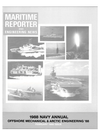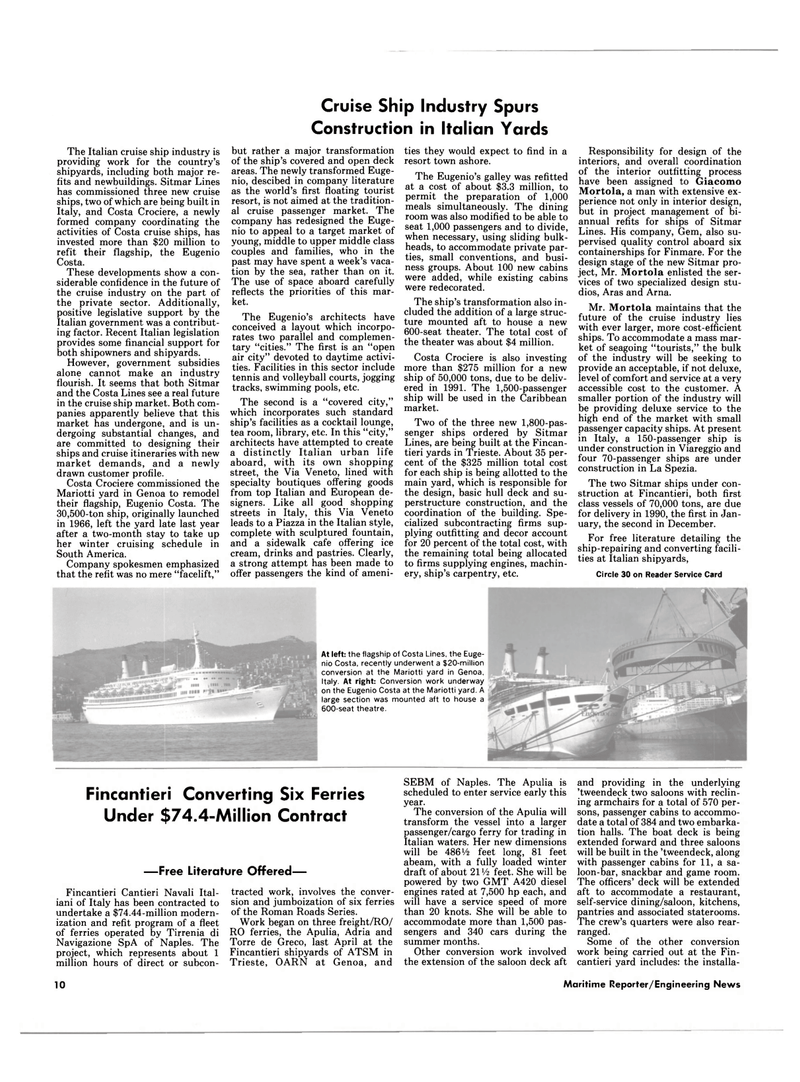
Page 8: of Maritime Reporter Magazine (February 1988)
Read this page in Pdf, Flash or Html5 edition of February 1988 Maritime Reporter Magazine
The Italian cruise ship industry is providing work for the country's shipyards, including both major re- fits and newbuildings. Sitmar Lines has commissioned three new cruise ships, two of which are being built in
Italy, and Costa Crociere, a newly formed company coordinating the activities of Costa cruise ships, has invested more than $20 million to refit their flagship, the Eugenio
Costa.
These developments show a con- siderable confidence in the future of the cruise industry on the part of the private sector. Additionally, positive legislative support by the
Italian government was a contribut- ing factor. Recent Italian legislation provides some financial support for both shipowners and shipyards.
However, government subsidies alone cannot make an industry flourish. It seems that both Sitmar and the Costa Lines see a real future in the cruise ship market. Both com- panies apparently believe that this market has undergone, and is un- dergoing substantial changes, and are committed to designing their ships and cruise itineraries with new market demands, and a newly drawn customer profile.
Costa Crociere commissioned the
Mariotti yard in Genoa to remodel their flagship, Eugenio Costa. The 30,500-ton ship, originally launched in 1966, left the yard late last year after a two-month stay to take up her winter cruising schedule in
South America.
Company spokesmen emphasized that the refit was no mere "facelift,"
Responsibility for design of the interiors, and overall coordination of the interior outfitting process have been assigned to Giacomo
Mortola, a man with extensive ex- perience not only in interior design, but in project management of bi- annual refits for ships of Sitmar
Lines. His company, Gem, also su- pervised quality control aboard six containerships for Finmare. For the design stage of the new Sitmar pro- ject, Mr. Mortola enlisted the ser- vices of two specialized design stu- dios, Aras and Arna.
Mr. Mortola maintains that the future of the cruise industry lies with ever larger, more cost-efficient ships. To accommodate a mass mar- ket of seagoing "tourists," the bulk of the industry will be seeking to provide an acceptable, if not deluxe, level of comfort and service at a very accessible cost to the customer. A smaller portion of the industry will be providing deluxe service to the high end of the market with small passenger capacity ships. At present in Italy, a 150-passenger ship is under construction in Viareggio and four 70-passenger ships are under construction in La Spezia.
The two Sitmar ships under con- struction at Fincantieri, both first class vessels of 70,000 tons, are due for delivery in 1990, the first in Jan- uary, the second in December.
For free literature detailing the ship-repairing and converting facili- ties at Italian shipyards,
Circle 30 on Reader Service Card
Cruise Ship Industry Spurs
Construction in Italian Yards but rather a major transformation of the ship's covered and open deck areas. The newly transformed Euge- nio, descibed in company literature as the world's first floating tourist resort, is not aimed at the tradition- al cruise passenger market. The company has redesigned the Euge- nio to appeal to a target market of young, middle to upper middle class couples and families, who in the past may have spent a week's vaca- tion by the sea, rather than on it.
The use of space aboard carefully reflects the priorities of this mar- ket.
The Eugenio's architects have conceived a layout which incorpo- rates two parallel and complemen- tary "cities." The first is an "open air city" devoted to daytime activi- ties. Facilities in this sector include tennis and volleyball courts, jogging tracks, swimming pools, etc.
The second is a "covered city," which incorporates such standard ship's facilities as a cocktail lounge, tea room, library, etc. In this "city," architects have attempted to create a distinctly Italian urban life aboard, with its own shopping street, the Via Veneto, lined with specialty boutiques offering goods from top Italian and European de- signers. Like all good shopping streets in Italy, this Via Veneto leads to a Piazza in the Italian style, complete with sculptured fountain, and a sidewalk cafe offering ice cream, drinks and pastries. Clearly, a strong attempt has been made to offer passengers the kind of ameni- ties they would expect to find in a resort town ashore.
The Eugenio's galley was refitted at a cost of about $3.3 million, to permit the preparation of 1,000 meals simultaneously. The dining room was also modified to be able to seat 1,000 passengers and to divide, when necessary, using sliding bulk- heads, to accommodate private par- ties, small conventions, and busi- ness groups. About 100 new cabins were added, while existing cabins were redecorated.
The ship's transformation also in- cluded the addition of a large struc- ture mounted aft to house a new 600-seat theater. The total cost of the theater was about $4 million.
Costa Crociere is also investing more than $275 million for a new ship of 50,000 tons, due to be deliv- ered in 1991. The 1,500-passenger ship will be used in the Caribbean market.
Two of the three new 1,800-pas- senger ships ordered by Sitmar
Lines, are being built at the Fincan- tieri yards in Trieste. About 35 per- cent of the $325 million total cost for each ship is being allotted to the main yard, which is responsible for the design, basic hull deck and su- perstructure construction, and the coordination of the building. Spe- cialized subcontracting firms sup- plying outfitting and decor account for 20 percent of the total cost, with the remaining total being allocated to firms supplying engines, machin- ery, ship's carpentry, etc.
At left: the flagship of Costa Lines, the Euge- nio Costa, recently underwent a $20-million conversion at the Mariotti yard in Genoa,
Italy At right: Conversion work underway on the Eugenio Costa at the Mariotti yard. A large section was mounted aft to house a 600-seat theatre.
Fincantieri Converting Six Ferries
Under $74.4-Million Contract —Free Literature Offered—
Fincantieri Cantieri Navali Ital- iani of Italy has been contracted to undertake a $74.44-million modern- ization and refit program of a fleet of ferries operated by Tirrenia di
Navigazione SpA of Naples. The project, which represents about 1 million hours of direct or subcon- tracted work, involves the conver- sion and jumboization of six ferries of the Roman Roads Series.
Work began on three freight/RO/
RO ferries, the Apulia, Adria and
Torre de Greco, last April at the
Fincantieri shipyards of ATSM in
Trieste, OARN at Genoa, and
SEBM of Naples. The Apulia is scheduled to enter service early this year.
The conversion of the Apulia will transform the vessel into a larger passenger/cargo ferry for trading in
Italian waters. Her new dimensions will be 486 Vz feet long, 81 feet abeam, with a fully loaded winter draft of about 21 Va feet. She will be powered by two GMT A420 diesel engines rated at 7,500 hp each, and will have a service speed of more than 20 knots. She will be able to accommodate more than 1,500 pas- sengers and 340 cars during the summer months.
Other conversion work involved the extension of the saloon deck aft and providing in the underlying 'tweendeck two saloons with reclin- ing armchairs for a total of 570 per- sons, passenger cabins to accommo- date a total of 384 and two embarka- tion halls. The boat deck is being extended forward and three saloons will be built in the 'tweendeck, along with passenger cabins for 11, a sa- loon-bar, snackbar and game room.
The officers' deck will be extended aft to accommodate a restaurant, self-service dining/saloon, kitchens, pantries and associated staterooms.
The crew's quarters were also rear- ranged.
Some of the other conversion work being carried out at the Fin- cantieri yard includes: the installa- 10 Maritime Reporter/Engineering News

 7
7

 9
9
